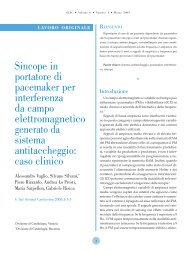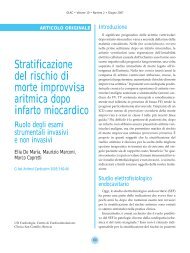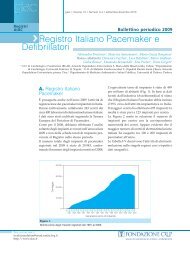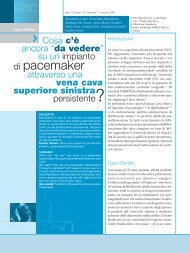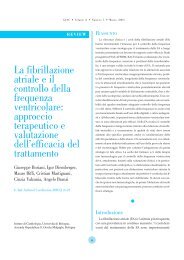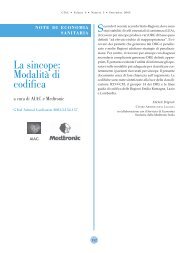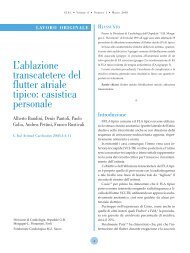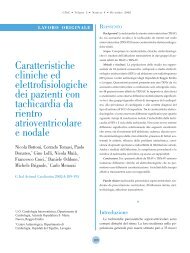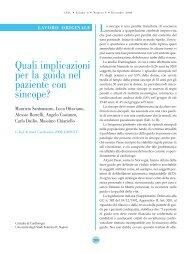âFenomenoâ di Brugada intermittente - Giornale Italiano di ...
âFenomenoâ di Brugada intermittente - Giornale Italiano di ...
âFenomenoâ di Brugada intermittente - Giornale Italiano di ...
You also want an ePaper? Increase the reach of your titles
YUMPU automatically turns print PDFs into web optimized ePapers that Google loves.
Un caso <strong>di</strong> “fenomeno” <strong>di</strong> <strong>Brugada</strong> <strong>intermittente</strong>elettrocar<strong>di</strong>ografica <strong>di</strong> fenomeno <strong>di</strong> <strong>Brugada</strong>. 6 In realtà,Priori et al. hanno recentemente condotto uno stu<strong>di</strong>osu 200 pazienti con sindrome <strong>di</strong> <strong>Brugada</strong>, la piùvasta popolazione <strong>di</strong>sponibile in letteratura, che ri<strong>di</strong>mensionail rischio <strong>di</strong> arresto car<strong>di</strong>aco in pazientidefiniti fenotipicamente negativi, cioè portatori <strong>di</strong> mutazionesul gene SCN5A in assenza <strong>di</strong> sintomi e <strong>di</strong>alterazioni tipiche basali elettrocar<strong>di</strong>ografiche, attestandosisu un’incidenza del 5% in 4 deca<strong>di</strong> <strong>di</strong> follow-up.19 Gli autori, inoltre, analizzano il ruolo, ancoraconflittuale, 20,21 del SEF come mezzo <strong>di</strong> stratificazioneprognostica, confermando precedentiosservazioni sul valore scarsamente pre<strong>di</strong>ttivo del SEF;in questo stu<strong>di</strong>o, infatti, i pazienti risultati inducibilial SEF non hanno mostrato un incremento del rischio<strong>di</strong> arresto car<strong>di</strong>aco rispetto ai pazienti non inducibili.Viene invece evidenziato il forte peso pre<strong>di</strong>ttivo dellapresenza simultanea <strong>di</strong> sincope nella storia clinica e<strong>di</strong> alterazioni <strong>di</strong>agnostiche all’ECG basale. La combinazione<strong>di</strong> queste 2 variabili cliniche ha in<strong>di</strong>viduatoun gruppo <strong>di</strong> pazienti con un’incidenza <strong>di</strong> arresto car<strong>di</strong>acodel 44%.Anche alla luce <strong>di</strong> questi recentissimi dati sulla storianaturale della sindrome <strong>di</strong> <strong>Brugada</strong>, il nostro pazientepuò essere considerato a basso profilo <strong>di</strong> rischioper morte car<strong>di</strong>aca e non can<strong>di</strong>dato all’impianto <strong>di</strong> unAICD. Diventa, invece, sempre più <strong>di</strong>scutibile la decisione<strong>di</strong> sottoporre a un SEF per induzione <strong>di</strong> aritmieun paziente con sindrome <strong>di</strong> <strong>Brugada</strong> asintomatico.Bibliografia1. <strong>Brugada</strong> P, <strong>Brugada</strong> J. Right bundle branch block, persistentST segment elevation and sudden car<strong>di</strong>ac death: a <strong>di</strong>stinct clinicaland electrocar<strong>di</strong>ographic syndrome. J Am Coll Car<strong>di</strong>ol1992;20:1391-1396.2. Nakazawa K, Matsumoto N, Takenobu H, et al. Characteristicsof i<strong>di</strong>opathic ventricular fibrillation: with reference to electrocar<strong>di</strong>ographicmorphology of RBBB and ST elevation. Heart(Jpn) 1994;26:26-31.3. Nakazawa K, Murayama M. The significance of autonomic nervoustone with i<strong>di</strong>opathic ventricular fibrillation in patients withright bundle branch block with ST elevation on ECG. Heart(Jpn) 1995;27:364-373.4. <strong>Brugada</strong> J, <strong>Brugada</strong> P. Right bundle branch block, ST segmentelevation and sudden car<strong>di</strong>ac death. Symptomatic, asymptomaticand intermittent forms. (Abstr). J Am Coll Car<strong>di</strong>ol1995;93:719-716.5. <strong>Brugada</strong> P, <strong>Brugada</strong> J, <strong>Brugada</strong> R. The <strong>Brugada</strong> syndrome. AnnNoninvasive Electrocar<strong>di</strong>ol 2000;5:88-91.6. <strong>Brugada</strong> R, <strong>Brugada</strong> J, Antzelevitch C, et al. So<strong>di</strong>um channelblockers identify risk for sudden death in patients with STsegmentelevation and right bundle branch block but structurallynormal hearts. Circulation 2000;8:510-515.7. Antzelevitch C, Nesterenko VV, Yan JX. Ionic processes underlingthe action potential. In: Liebman J, e<strong>di</strong>tor, Electrogar<strong>di</strong>ology’96: From the Cell to the Body Surface. Singapore: WorldScientific Publishing Co. Pte. Ltd 1996:219-229.8. Martini B, Nava A, Thiene G, et al. Ventricular fibrillationwithout apparent heart <strong>di</strong>sease. Description of six cases. AmHeart J 1989;118:1203-1209.9. Chen Q, Kirsch GE, Zhang D, et al. Genetic basis and molecularmechanism for i<strong>di</strong>opathic ventricular fibrillation. Nature1998;392:293-296.10. Barry DM, Nerbonne JM. Myocar<strong>di</strong>al channels: electrophysiologicaland molecular density. Annu Rev Physiol 1996;58:363-394.11. Priori SG, Napolitano C, Giordano U, et al. <strong>Brugada</strong> syndromeand sudden car<strong>di</strong>ac death in children. Lancet 2000;355:808-809.12. Kasanuki H, Ohnishi S, Ohtuka M, et al. I<strong>di</strong>opathic ventricularfibrillation induced with vagal activity in patients without obviousheart <strong>di</strong>sease. Circulation 1997;95:2277-2285.13. <strong>Brugada</strong> J, <strong>Brugada</strong> R, <strong>Brugada</strong> P. Right bundle-branch blockand ST-segment elevation in leads V1 through V3. A marker forsudden death in patients without demonstrable structural heart<strong>di</strong>sease. Circulation 1998;97:457-460.14. Osher HL, Wolff L. Electrocar<strong>di</strong>ographic pattern simulatingacute myocar<strong>di</strong>al injury. Am J Med Sci 1953;226:541-545.15. Miyazaki T, Mitamura H, Myoshi S. Autonomic and antiarrhythmicmodulation of ST segment elevation in patients with <strong>Brugada</strong>syndrome. J Am Coll Car<strong>di</strong>ol 1996;27:1061-1070.16. <strong>Brugada</strong> P. Unpublished observations.17. <strong>Brugada</strong> J, <strong>Brugada</strong> P, <strong>Brugada</strong> R. The syndrome of right bundlebranch block ST segment elevation in V1 lo V3 and suddendeath – the <strong>Brugada</strong> syndrome. Europace 1999;1:156-166.18. <strong>Brugada</strong> J, <strong>Brugada</strong> R, <strong>Brugada</strong> P. Pharmacological and deviceapproach to therapy of inherited car<strong>di</strong>ac <strong>di</strong>seases associatedwith car<strong>di</strong>ac arrhythmias and sudden death. J Electrocar<strong>di</strong>ol2000;33:41-47.19. Priori SG, Napolitano C, Gasparini M, et al. Natural history of<strong>Brugada</strong> syndrome: insights for risk stratification and management.Circulation 2002;105:1342-1347.20. Priori SG. Foretelling the future in <strong>Brugada</strong> syndrome: do wehave the crystal ball? J Car<strong>di</strong>ovasc Electrophysiol 2001;12:1008-1009.21. <strong>Brugada</strong> P, Geelen P, <strong>Brugada</strong> R, et al. Prognostic value ofelectrophysiologic investigations in <strong>Brugada</strong> syndrome. J Car<strong>di</strong>ovascElectrophysiol 2001;12:1004-1007.In<strong>di</strong>rizzo per la corrispondenzaBiagio SassoneOspedale <strong>di</strong> BentivoglioU.O. <strong>di</strong> Car<strong>di</strong>ologiaVia Marconi, 3540010 Bentivoglio (BO)Tel.: 051/6644128Fax: 051/6644587e-mail: biagio64@libero.it121



